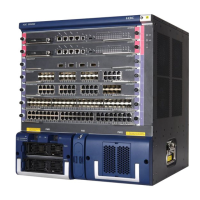Smart link
: allows 50 ms failover between links
Graceful restart
: features are fully supported, including graceful restart for OSPF, IS-IS, BGP, LDP, and RSVP; network remains
stable during the active-standby switchover; after the switchover, the device quickly learns the network routes by
communicating with adjacent routers; forwarding remains uninterrupted during the switchover to realize nonstop forwarding
(NSF)
IP/LDP FRR
: nodes are configured with backup ports, routes, and LSPs; local implementation requires no cooperation of adjacent
devices, simplifying the deployment; solves the traditional convergence faults in IP forwarding and MPLS forwarding, protecting
the links, nodes, and paths without establishing respective backup LSPs for them; realizes restoration within 50 ms, with the
restoration time independent of the number of routes and fast link switchovers, without route convergence
Ring Resiliency Protection Protocol
(RRPP): provides standard sub-200 ms recovery for ring Ethernet-based topology
Layer 2 switching
VLANs
: support up to 4,096 port or IEEE 802.1Q-based VLANs
Spanning Tree Protocol
: fully supports standard IEEE 802.1D Spanning Tree Protocol, IEEE 802.1w Rapid Spanning Tree
Protocol for faster convergence, and IEEE 802.1s Multiple Spanning Tree Protocol
Internet Group Management Protocol
(IGMP)
and Multicast Listener Discovery
(MLD)
protocol snooping
: effectively control
and manage the flooding of multicast packets in a Layer 2 network
Port isolation
: increases security by isolating ports within a VLAN while still allowing them to communicate with other VLANs
GARP VLAN Registration Protocol
: allows automatic learning and dynamic assignment of VLANs
Bridge Protocol Data Unit
(BPDU)
tunneling
: transmits Spanning Tree Protocol BPDUs transparently, allowing correct tree
calculations across service providers, WANs, or MANs
Port mirroring
: duplicates port traffic (ingress and egress) to a local or remote monitoring port; supports 64 mirroring groups,
with an unlimited number of ports per group
Device Link Detection Protocol
(DLDP): monitors link connectivity and shuts down ports at both ends if uni-directional traffic is
detected, preventing loops in STP-based networks
IEEE 802.1ad QinQ and Selective QinQ
: increase the scalability of an Ethernet network by providing a hierarchical structure;
connect multiple LANs on a high-speed campus or metro network
Layer 3 services
Address Resolution Protocol
(ARP): determines the MAC address of another IP host in the same subnet; supports static ARPs;
gratuitous ARP allows detection of duplicate IP addresses; proxy ARP allows normal ARP operation between subnets or when
subnets are separated by a Layer 2 network
User Datagram Protocol
(UDP)
helper
: redirects UDP broadcasts to specific IP subnets to prevent server spoofing
Dynamic Host Configuration Protocol
(DHCP): simplifies the management of large IP networks and supports client and server;
DHCP Relay enables DHCP operation across subnets
Layer 3 routing
Static IPv4 routing
: provides simple, manually configured IPv4 routing
Routing Information Protocol
: uses a distance vector algorithm with UDP packets for route determination; supports RIPv1 and
RIPv2 routing; includes loop protection
OSPF
: Interior Gateway Protocol (IGP) uses link-state protocol for faster convergence; supports ECMP, NSSA, and MD5
authentication for increased security and graceful restart for faster failure recovery
Border Gateway Protocol 4
(BGP-4): Exterior Gateway Protocol (EGP) with path vector protocol uses TCP for enhanced reliability
for the route discovery process, reduces bandwidth consumption by advertising only incremental updates, and supports
extensive policies for increased flexibility, as well as scales to very large networks
Intermediate system to intermediate system
(IS-IS): Interior Gateway Protocol (IGP) uses path vector protocol, which is
QuickSpecs
HP 9500 Switch Series
Overview
DA - 13773 North America — Version 10 — July 12, 2013
Page 4

